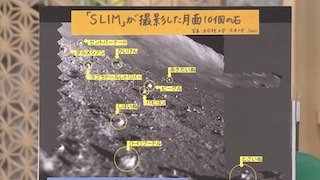TOKYO, Jun 03 (News On Japan) – ‘How was the moon born?’ Of the various hypotheses, the ‘Giant Impact Hypothesis’ is the most supported. This theory suggests that material from Earth is part of the moon’s interior. To investigate this, Japan’s first successful lunar lander, SLIM, deliberately landed in a challenging area near a crater. The special camera on board captured important images. What does the analysis of these images reveal about the moon’s origins?
The success of SLIM, Japan’s first lunar lander, depended on its landing location. It landed on a slope near a crater, where there are many rocks. The challenging landing site was chosen to fulfill the crucial mission of investigating the moon’s origins. About 4.6 billion years ago, the solar system formed from gas and dust in space. As the temperature, pressure and density increased at the center, the sun was born. The remaining gas and dust collided to form planets like Earth. However, the exact formation process of the moon remains unclear.
Four main theories exist about the origin of the moon. The ‘Twin Theory’ states that the moon and the earth formed simultaneously. The ‘Parent-Child Theory’ suggests that the moon split from part of the Earth. The ‘Capture Theory’ states that the moon formed somewhere else and was captured by Earth’s gravity. However, the most widely supported theory is the ‘Giant Impact Hypothesis’, which suggests that a body the size of Mars collided with Earth, spreading material from the Earth’s mantle into space and eventually forming the moon.
To support the Giant Impact Hypothesis, it is crucial to confirm that the moon’s internal materials are similar to Earth’s mantle. The key is olivine, a mineral formed from cooled mantle material, which is also found around volcanoes on Earth. The presence of similar rocks on the lunar surface, especially around the crater where SLIM landed, is critical to this research. Craters are formed by meteorite impacts, which scatter rocks from the moon’s interior around the impact site. SLIM was strategically positioned to examine these stones up close.
The research team marked ten stones captured by SLIM’s special camera and named them after dog breeds. The camera analyzes the wavelengths of light to identify the substances in the rocks. One stone, called ‘Dalmatian’, was found to contain olivine. Further analysis of this olivine, comparing it to that of Earth, could strengthen the Giant Impact Hypothesis. How close can we get to unraveling the moon’s origins?
Source: TBS



